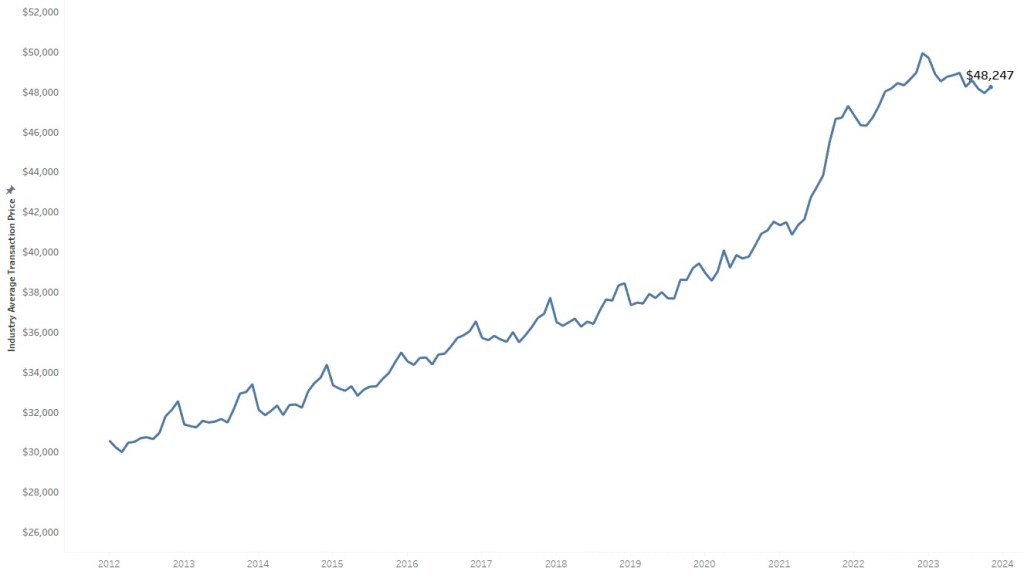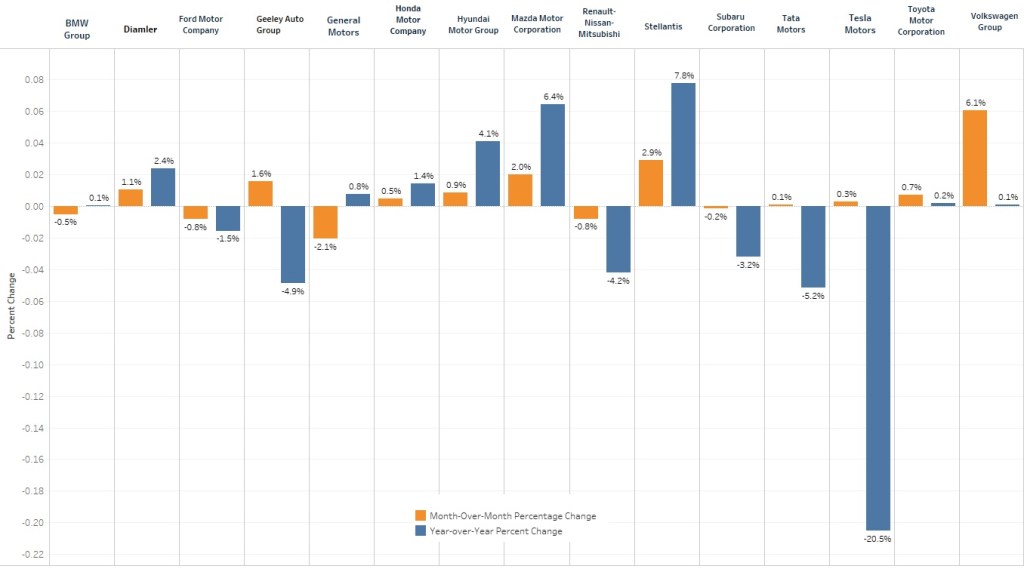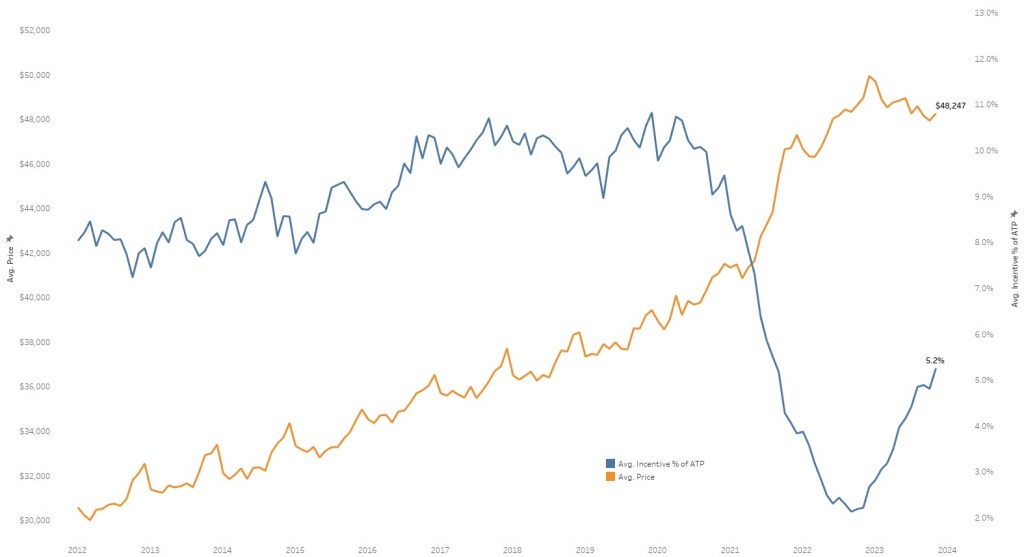Data Point
U.S. New-Vehicle Prices Down Year Over Year for Third Straight Month; Market Shifts Toward Buyers as Incentives Climb, Profit Margins Squeezed
Monday December 11, 2023
Article Highlights
- The average transaction price (ATP) for a new vehicle in November 2023 was $48,247, an increase from last month but down 1.5% year over year.
- After retreating slightly in October, incentives increased further in November, reaching a new high for 2023 and climbing above 5% of ATP for the first time in more than two years.
- Luxury vehicle prices in November were lower by more than 7.5% year over year; luxury share of the U.S. market surpassed 20% share, a record high.
ATLANTA, Dec. 11, 2023 – The U.S. new-vehicle average transaction price in November 2023 was $48,247, an increase of less than 1% month over month and down year over year by 1.5%, according to data released today from Kelley Blue Book, a Cox Automotive company. November marks the third consecutive month that new-vehicle transaction prices were lower year over year, a unique milestone for the industry. In fact, the past three months mark the only time in the past decade that the monthly new-vehicle ATPs did not increase year over year.
In addition, new-vehicle sales incentives climbed further in November 2023 after retreating slightly in October, surpassing 5% of the average transaction price (ATP) for the first time since September 2021. New-vehicle sales incentives were up 136% year over year in November, indicating the new-vehicle market is shifting to a buyer’s market, not a seller’s market.
NEW-VEHICLE AVERAGE TRANSACTION PRICE

Lower ATPs for vehicle buyers continue to be the results of discounts and incentives, not lower-priced automobiles, the Kelley Blue Book data suggests. The average price lost ground on the average manufacturer’s suggested retail price (MSRP), declining to 98.3% in November, the lowest level since April 2021. The average price decreased 1.5% from a year ago, while the average MSRP increased nearly 1% from a year ago. In the past decade, new-vehicle MSRPs have never decreased year over year.
“While consumers may feel some relief in vehicle prices and incentives as we close out 2023, automakers and dealers are feeling the results of the downward price pressure,” said Rebecca Rydzewski, research manager at Cox Automotive. “The latest dealer sentiment survey by Cox Automotive clearly indicates that dealers are seeing profits contract as inventory levels return to normal, and incentives are turned up to help stimulate sales.”
Of the 35 brands that Kelley Blue Book included in its November analysis, 16 had year-over-year price declines in November, with the largest declines recorded for Tesla (-20.5%), Buick (-6.4%), Land Rover (-6.0%) and Nissan (-5.7%). The largest year-over-year transaction-price increases came from Dodge (11.2%), Ram (10.5%), Audi (7.8%) and GMC (7.8%).
PRICE CHANGE PERCENTAGE BY AUTOMAKER

New-Vehicles Incentives Up 136% Year Over Year in November
The sales incentive package in November was 5.2% of the transaction price, more than twice the level from one year ago when the average incentive package was 2.2%. While incentives declined slightly during October, they rebounded in November to reach the highest point of the year.
INDUSTRY AVERAGE TRANSACTION PRICE VERSUS INDUSTRY AVERAGE INCENTIVE SPEND AS % OF ATP

Incentives for luxury cars and electric vehicles were above 8%, well above the industry average. Conversely, full-size SUVs, minivans and small/mid-size pickups had some of the smallest incentives last month, all well below 3%.
Luxury Vehicle Prices Lead Market Prices Lower, Non-Luxury Mostly Steady
Lower prices on luxury vehicles are likely helping to stimulate sales at a time of year when sales of luxury vehicles normally accelerate. Last month, in a market that posted an 8.4% year-over-year increase in sales, luxury brand sales jumped 19.6% year over year, while non-luxury vehicle sales increased approximately 5.9%. Luxury share of the U.S. market was above 20% for the first time on record, according to the Kelley Blue Book data.
The average price paid for a luxury vehicle in November was $63,235, an increase of less than 1% from October but down 7.5% year over year, when the inventory shortage began to ease. Luxury brand incentives averaged 5.8% of ATP in November, up from 4.6% in October and 5.4% in September. Tesla, Buick, Land Rover, Volvo and Acura had the largest ATP declines last month among luxury brands in the Kelley Blue Book database.
For non-luxury brands, the average price paid in November was $44,417, an increase of less than $100 from October but lower year over year by 0.3%. Non-luxury incentives averaged 5%, up from 4.9% in the previous month and 4.7% in September. Non-luxury incentives are currently seen as low by historical standards, despite being at their highest point since September 2021. For comparison, non-luxury incentive packages averaged 10.5% of ATP in November 2019.
EV Price Parity Approaches
The average price paid for a new electric vehicle in November was $52,345, up from a revised $51,715 in October and supported by incentive levels well above the industry average. In November, EV incentives reached their highest point of 2023 at 8.9% of ATP. A year ago, EV incentives were less than 2% of ATP. Thanks in part to discounts and above-average inventory levels, EV transaction prices last month were only 8.5% higher than the industry average price of $48,247.
“In recent months, price parity between EVs and ICE has almost seemed possible,” added Stephanie Valdez-Streaty, director of Strategic Planning at Cox Automotive. “It is a complicated measure with plenty of variables, but newer products and higher discounts have brought down average EV prices, even before potential tax incentives. A year ago, the EV premium was more than 30%. Today, it’s less than 10%.”
